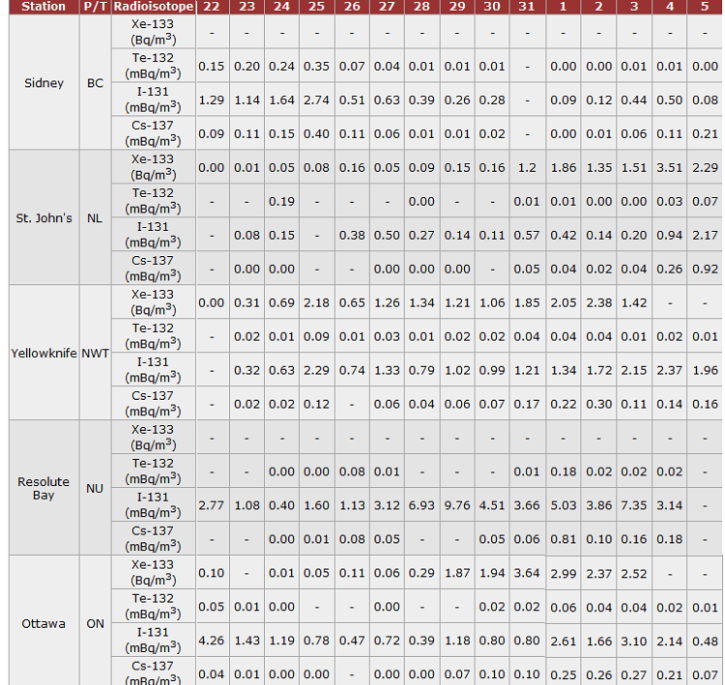Canadian Radiation Readings
Health Canada’s Fixed Point Surveillance Network Data
Click Here For The Latest Data
As part of routine operations, Health Canada’s Radiation Protection Bureau conducts 24/7 environmental monitoring across Canada using the Fixed Point Surveillance (FPS) network. Unlike the particulate and noble gas systems, these detectors do not concentrate radioactive material but rather report on the radiation levels from all gamma-emitting isotopes around the detector in near-real-time. As a result, they are less sensitive to low levels of radiation in air, but are better able to indicate changes in environmental radiation exposure. This information is being reported as a gamma radiation dose per day.
The following charts depict the average daily radiation dose from the environment for the month of April. In order to compare the actual daily values and account for normal fluctuations, the chart includes measured baseline values from 2010 (minimum, maximum and average over the entire year). Numbers are micro-Seiverts per day.
Canadian Comprehensive Nuclear-Test-Ban Treaty Station Radioisotope Concentrations
Click Here For The Latest Data
Under the Comprehensive Nuclear-Test-Ban Treaty (CTBT) International Monitoring System (IMS), Health Canada’s Radiation Protection Bureau operates four certified IMS particulate monitoring stations (Sidney, BC; Yellowknife, NWT; Resolute Bay, NU; and St John’s, NL), two experimental noble gas systems (Yellowknife and St. John’s), and one station in Ottawa, ON.
All systems collect air over 24-hour sampling periods and concentrate radioisotopes so that they can be measured by gamma radiation detectors. By concentrating the material, it is possible to detect much lower quantities of radioactivity in air than with a real-time monitoring system, such as the Fixed Point Surveillance Network. In fact, it was the monitoring station in Sydney BC that detected the first radioactive isotopes coming from Japan.
The measurements in the following charts show the concentrations of radioisotopes in the air.
All of the Canadian CTBT stations collect data for cesium-137, iodine-131, and tellurium-132. These data are reported in milliBecquerels per cubic meter (mBq/m3).
Only Yellowknife, Ottawa, and St John’s are equipped to collect data for xenon-133, which is a noble gas. Noble gases do not react with other elements in the environment. As a result, they do not settle out of the plume but travel long distances in the atmosphere and are detected in relatively high concentrations.
Because the activities are relatively high, xenon-133 measurements are reported in Becquerels per cubic meter.


